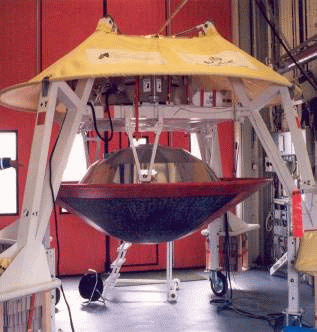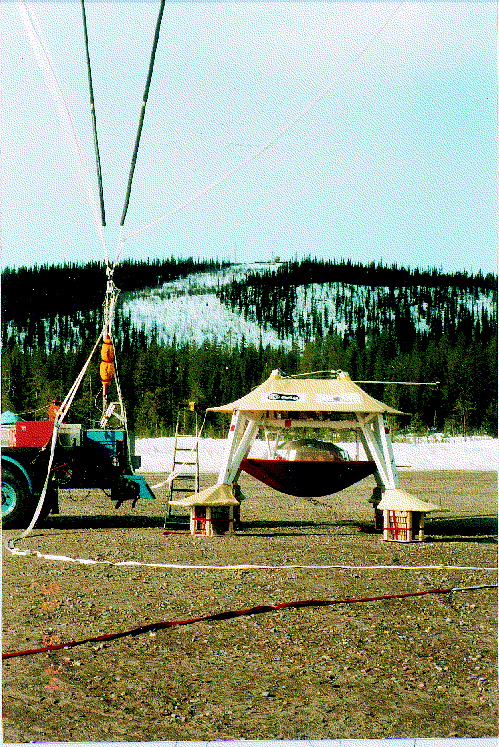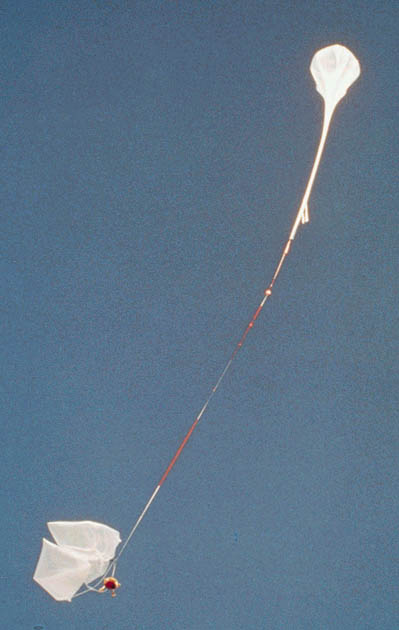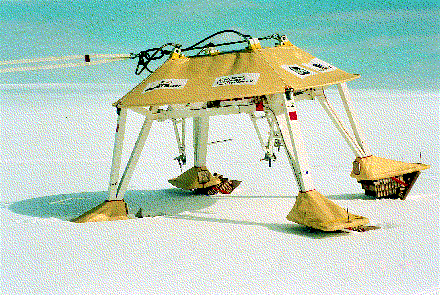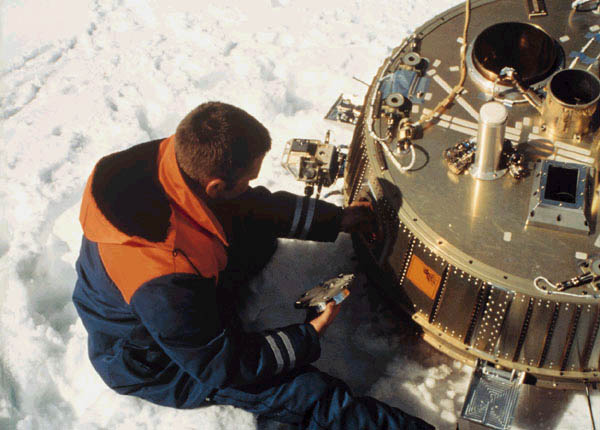Purpose of the flight and payload description
The HUYGENS probe was designed to enter and brake in Titan's atmosphere and parachute a fully instrumented robotic laboratory down to the surface as part of the NASA/ESA/ASI mission CASSINI devoted to study Saturn and his moons. The mission, launched in October of 1997, reached Saturn's orbit on July 2004. Orbital entry of Huygens occured on January 15, 2005. The probe studied the clouds, atmosphere, and surface of Titan in its descent.
As part of the research program of the mission, between 1995 and 2004 different agencies participating of the program performed a series of balloon-borne missions using different mockups of the probe, or specially built gondolas for testing different sub-systems and sensors. Another series of tests were made to validate the behaviour of the probe with atmospheric environment and to simulate orbital entry into Titan's atmosphere performing several balloon-borne drop tests.
The aim of the flight was to perform a drop test from the stratosphere of a special full-sized model of the Huygens probe, designated SM2. The specific objectives of the test were to demonstrate the descent sequence under dynamic conditions, the functioning of the descent subsystem, including the deployment, inflation, drag coefficient, structural strength and stability of the parachutes, the operation of the parachute deployment device, separation of the back cover, separation of the front shield and operation of the parachute jettisoning mechanism, the functioning of the spin vanes under the stabilising drogue chute and to provide the data needed to correlate predictions with flight results.
The external shape of the SM2 Probe was almost identical to that of the flight model that descended into Titan's atmosphere. The inner structure was built to flight-standard, as were the back-cover and front-shield release mechanisms and the descent control sub-system. A special bracket was added to interface the Probe and the gondola to allow a pyrotechnic separation, with umbilical separation provided by a lanyard.
Details of the balloon flight
Balloon launched on: 5/14/1995 at 6:52
Launch site: European Space Range, Kiruna, Sweden
Balloon launched by: Centre National d'Etudes Spatiales (CNES)
Balloon manufacturer/size/composition: Zero Pressure Balloon model 400z Zodiac - 400.000 m3
Balloon serial number: 400Z Nº 59
End of flight (L for landing time, W for last contact, otherwise termination time): 5/14/1995 at ~ 09:10
Balloon flight duration (F: time at float only, otherwise total flight time in d:days / h:hours or m:minutes - ): 2 h 19 m
Campaign: HUYGENS
Payload weight: 1.086 kgs
Gondola weight: 731 kgs
The balloon was launched at 8.15 local time on 14th May 1995, using the dynamic method with help of auxiliary balloon. After an nominal ascent phase the Probe was released from the gondola at 11.09 local time from an altitude of 37.4 km. The descent module landing occured at 11.27 and the craft was in good shape and operational once on the ground. The Probe and the gondola were both recovered and flown back by helicopter to the launch site the same day. The front shield and back cover were located the same day, but recovered hours later.
All of the Probe's systems functioned perfectly during the descent and was operational after landing and good data were transmitted to ground via the gondola, which had a much longer descent time.
All three flight parachutes - pilot, main and stabiliser - deployed cleanly and inflated very positively. Pilot- and main-chute inflation occurred at Mach 0.8, at a dynamic pressure representative of conditions on Titan. The parachute deployment and inflation times were as predicted, and the drag coefficients were also within specification.
Detailed analysis of the film taken confirmed that there was no post-separation contact between the Probe and its back cover or front shield. The back-cover separation was slightly faster than predicted, due to a lower Probe wake recirculation (subsonic) compared with the predicted Titan-entry case (supersonic). The front shield's separation showed good correlation between predictions and flight results.
Although the individual parachutes and mechanisms had already been tested extensively at subsystem and system level, the SM2 Probe Drop Test demonstrated the descent sequence under realistic dynamic conditions for the first time and has thereby provided the necessary total confidence regarding the flight-model Probe's successful descent into Titan's atmosphere in November 2004.
External references
- Advanced drop tests from stratospheric balloons SpaceOps 2012 Conference Stockholm, Sweden
- Characterization of the spin and attitude of the ESA Huygens probe during its descent onto Titan using the engineering dataset Graduation thesis written by Alain Sarlette, Liege University, Faculty of Applied Sciences
- Comparison of the Huygens mission and the SM2 test flight for Huygens attitude reconstruction 3rd International Planetary Probe Workshop, Anavyssos / Greece (2005)
- Drop test of the Huygens probe from a stratospheric balloon Advances in Space Research, Volume 21, Issue 7, p. 1033
- Drop Testing the Huygens Probe ESA Bulletin Nr. 85.Published February 1996
- List of balloons launched from ESRANGE SSC Space website (via Archive.Org)
1244If you consider this website interesting or useful, you can help me to keep it up and running with a small donation to cover the operational costs. Just the equivalent of the price of a cup of coffee helps a lot.

